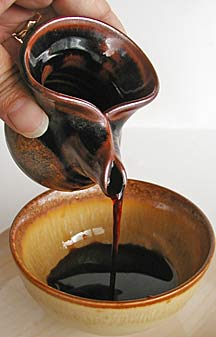|
Key Ingredient
|
Tamari

|
Tamari was once reserved for strict health-food types, but today it is the choice of condiment for people looking for a less intense soy sauce flavor.
The basics: Tamari is very similar to soy sauce, which is made from soy beans. The difference is that tamari is made with little or no roasted wheat.
Tamari consists of soybeans, salt and a type of mold called koji that allows the soybeans to ferment and develop unique enzymes.
Traditionally, tamari was a byproduct of the miso-making process, but today it is brewed with the purpose of creating a slightly thicker, dark brown, liquid condiment.
The flavor is similar to soy sauce, but many say it has a mellower edge. It is comparable to soy sauce in salt content, but is preferred by those on strict wheat-free diets.
Tamari gained much attention in the '60s with the introduction of the macrobiotic diet and its emphasis on natural, whole, unprocessed foods. From there it became part of the American health-food craze. Soy sauce use still far exceeds tamari, however.
Selecting: Tamari is generally sold bottled in small quantities. There are a number of brands to choose from, including those made from organic soybeans. If you are looking for a product that is totally wheat-free, make sure to check the labels -- some tamari contains small amounts of wheat.
Storing: Tamari, like soy sauce, should be stored in a cool, dry area and will keep for several months. Refrigerate for longer storage.
Use: Tamari is used as a flavor enhancer in soups, stews, sauces and marinades. It's also ideal in dressings and as a dipping sauce. Or drizzle tamari over meat or vegetable dishes in place of salt.
Where to buy: Tamari is available at a few supermarkets and Asian markets. A better source is health-food stores, which carry a wider range of brands, including organic varieties.
Average price is $2 to $3 for an 8- to 9-ounce bottle.
![]()
a free-lance food writer. Contact her
online through features@starbulletin.com
[News] [Business] [Features] [Sports] [Editorial] [Do It Electric!]
[Classified Ads] [Search] [Subscribe] [Info] [Letter to Editor]
[Feedback]
